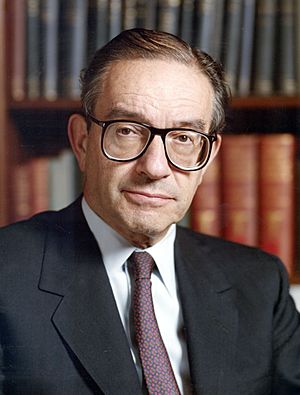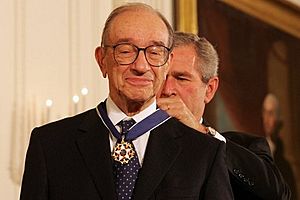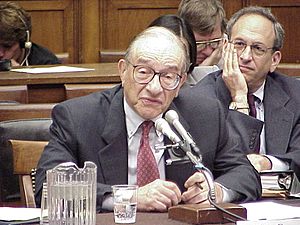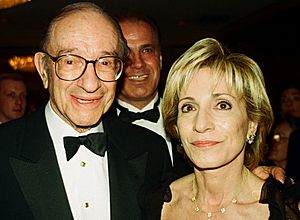Alan Greenspan facts for kids
Quick facts for kids
Alan Greenspan
|
|
|---|---|
 |
|
| 13th Chairman of the Federal Reserve | |
| In office August 11, 1987 – January 31, 2006 |
|
| President | |
| Deputy |
|
| Preceded by | Paul Volcker |
| Succeeded by | Ben Bernanke |
| Member of the Federal Reserve Board of Governors | |
| In office August 11, 1987 – January 31, 2006 |
|
| President |
|
| Preceded by | Paul Volcker |
| Succeeded by | Ben Bernanke |
| 10th Chairman of the Council of Economic Advisers | |
| In office September 4, 1974 – January 20, 1977 |
|
| President | Gerald Ford |
| Preceded by | Herbert Stein |
| Succeeded by | Charles Schultze |
| Personal details | |
| Born | March 6, 1926 New York City, U.S. |
| Political party | Republican |
| Spouses | |
| Education | |
Alan Greenspan (born March 6, 1926) is an American economist who served as the 13th chairman of the Federal Reserve from 1987 to 2006. He worked as a private adviser and provided consulting for firms through his company, Greenspan Associates LLC.
First nominated to the Federal Reserve by President Ronald Reagan in August 1987, Greenspan was reappointed at successive four-year intervals until retiring on January 31, 2006, after the second-longest tenure in the position, behind only William McChesney Martin. President George W. Bush appointed Ben Bernanke as his successor. Greenspan came to the Federal Reserve Board from a consulting career. Although he was subdued in his public appearances, favorable media coverage raised his profile to a point that several observers likened him to a "rock star". Democratic leaders of Congress criticized him for politicizing his office because of his support for Social Security privatization and tax cuts.
Many have argued that the "easy-money" policies of the Fed during Greenspan's tenure, including the practice known as the "Greenspan put", were a leading cause of the dot-com bubble and subprime mortgage crisis (the latter occurring within a year of his leaving the Fed), which, said The Wall Street Journal, "tarnished his reputation". Yale economist Robert Shiller argues that "once stocks fell, real estate became the primary outlet for the speculative frenzy that the stock market had unleashed". Greenspan has argued that the housing bubble was not a result of low-interest short-term rates but rather a worldwide phenomenon caused by the progressive decline in long-term interest rates – a direct consequence of the relationship between high savings rates in the developing world and its inverse in the developed world.
Contents
Early life and education
Greenspan was born in the Washington Heights area of New York City. His father, Herbert Greenspan, was of Romanian Jewish descent, and his mother, Rose Goldsmith, was of Hungarian Jewish descent. After his parents divorced, Greenspan grew up with his mother in the household of his maternal grandparents who were born in Russia. His father worked as a stockbroker and consultant in New York City.
Greenspan attended George Washington High School from 1940 until he graduated in June 1943, where one of his classmates was John Kemeny. He played clarinet and saxophone along with Stan Getz. He further studied clarinet at the Juilliard School from 1943 to 1944. Among his bandmates in the Woody Herman band was Leonard Garment, Richard Nixon's special counsel. In 1945, Greenspan attended New York University's Stern School of Business, where he earned a B.A. degree in economics summa cum laude in 1948 and an M.A. degree in economics in 1950. At Columbia University, he pursued advanced economic studies under Arthur Burns but withdrew because of his increasing work demand at Townsend-Greenspan & Company.
In 1977, Greenspan obtained a Ph.D. in economics from New York University. His dissertation is not available from the university since it was removed at Greenspan's request in 1987, when he became chairman of the Federal Reserve Board. In April 2008, however, Barron's obtained a copy and notes that it includes "a discussion of soaring housing prices and their effect on consumer spending; it even anticipates a bursting housing bubble".
Career
Before the Federal Reserve
During his economics studies at New York University, Greenspan worked under Eugene Banks, a managing director at the Wall Street investment bank Brown Brothers Harriman, in the firm's equity research department. From 1948 to 1953, Greenspan worked as an analyst at the National Industrial Conference Board (currently known as the Conference Board), a business- and industry-oriented think tank in New York City. Before he was appointed chairman of the Federal Reserve, from 1955 to 1987, Greenspan was chairman and president of Townsend-Greenspan & Co., Inc., an economics consulting firm in New York City. His 32-year stint there was interrupted only from 1974 to 1977, when he served as chairman of the Council of Economic Advisers, under President Gerald Ford.
In mid-1968, Greenspan agreed to serve as Richard Nixon's coordinator on domestic policy in the nomination campaign. Greenspan has also served as a corporate director for Aluminum Company of America (Alcoa); Automatic Data Processing; Capital Cities/ABC, Inc.; General Foods; J.P. Morgan & Co.; Morgan Guaranty Trust Company; Mobil Corporation; and the Pittston Company. He was a director of the Council on Foreign Relations foreign policy organization between 1982 and 1988. He also served as a member of the influential Washington-based financial advisory body, the Group of Thirty in 1984.
Chairman of the Federal Reserve
| What I've learned at the Federal Reserve is a new language which is called "Fed-speak". You soon learn to mumble with great incoherence. |
| — Alan Greenspan |
On June 2, 1987, President Ronald Reagan nominated Greenspan as a successor to Paul Volcker, as chairman of the Board of Governors of the Federal Reserve, and the Senate confirmed him on August 11, 1987. Investor, author and commentator Jim Rogers has said that Greenspan lobbied to get this chairmanship.
Two months after his confirmation, Greenspan said immediately following the 1987 stock market crash that the Fed "affirmed today its readiness to serve as a source of liquidity to support the economic and financial system". Although the Federal Reserve followed its announcement with monetary policy actions, which became known as the Greenspan put, George H. W. Bush attributed his re-election loss to a sluggish response. Democratic president Bill Clinton reappointed Greenspan, and consulted him on economic matters. Greenspan lent support to Clinton's 1993 deficit reduction program. Greenspan was fundamentally a monetarist and Austrian Economist in orientation on the economy, and his monetary policy decisions largely followed standard Taylor rule prescriptions (see Taylor 1993 and 1999). Greenspan also played a key role in organizing the U.S. bailout of Mexico during the 1994–1995 Mexican peso crisis.
In 2000, Greenspan raised interest rates several times; these actions were believed by many to have caused the bursting of the dot-com bubble. According to Nobel laureate Paul Krugman, however, "he didn't raise interest rates to curb the market's enthusiasm; he didn't even seek to impose margin requirements on stock market investors. Instead, he waited until the bubble burst, as it did in 2000, then tried to clean up the mess afterward". E. Ray Canterbery agrees with Krugman's criticism.
In January 2001, Greenspan, in support of President Bush's proposed tax decrease, stated that the federal surplus could accommodate a significant tax cut while paying down the national debt.
In autumn 2001, as a decisive reaction to the September 11 attacks and various corporate scandals which undermined the economy, the Greenspan-led Federal Reserve initiated a series of interest cuts that brought down the federal funds rate to 1% in 2004. While presenting the Federal Reserve's Monetary Policy Report in July 2002, he said that "It is not that humans have become any more greedy than in generations past. It is that the avenues to express greed had grown so enormously", and suggested that financial markets need to be more regulated. His critics, led by Steve Forbes, attributed the rapid rise in commodity prices and gold to Greenspan's loose monetary policy, which Forbes believed had caused excessive asset inflation and a weak dollar. By late 2004, the price of gold was higher than its 12-year moving average.
Greenspan advised senior members of the George W. Bush administration to depose Saddam Hussein for the sake of the oil markets. He believed that even a moderate disruption to the flow of oil could translate into high oil prices, which could lead to "chaos" in the global economy and bring the industrial world "to its knees". He feared that Saddam could seize control of the Straits of Hormuz and restrict the transport of oil through them. In a 2007 interview, he said, "people do not realize in this country, for example, how tenuous our ties to international energy are. That is, we on a daily basis require continuous flow. If that flow is shut off, it causes catastrophic effects in the industrial world. And it's that which made him [Saddam] far more important to get out than bin Laden."
On May 18, 2004, Greenspan was nominated by President George W. Bush to serve for an unprecedented fifth term as chairman of the Federal Reserve. He was previously appointed to the post by Presidents Reagan, George H. W. Bush, and Bill Clinton.
In a May 2005 speech, Greenspan stated: "Two years ago at this conference I argued that the growing array of derivatives and the related application of more-sophisticated methods for measuring and managing risks had been key factors underlying the remarkable resilience of the banking system, which had recently shrugged off severe shocks to the economy and the financial system. At the same time, I indicated some concerns about the risks associated with derivatives, including the risks posed by concentration in certain derivatives markets, notably the over-the-counter (OTC) markets for U.S. dollar interest rate options."
Greenspan opposed tariffs against the People's Republic of China for its refusal to let the yuan rise, suggesting instead that any American workers displaced by Chinese trade could be compensated through unemployment insurance and retraining programs.
Greenspan's term as a member of the board ended on January 31, 2006, and Ben Bernanke was confirmed as his successor.
As chairman of the board, Greenspan did not give any broadcast interviews from 1987 through 2005.
After the Federal Reserve
Immediately after leaving the Fed, Greenspan formed an economic consulting firm, Greenspan Associates LLC. He also accepted an honorary (unpaid) position at HM Treasury in the United Kingdom.
On February 26, 2007, Greenspan forecast a possible recession in the United States before or in early 2008. Stabilizing corporate profits are said to have influenced his comments. The following day, the Dow Jones Industrial Average decreased by 416 points, losing 3.3% of its value.
In May 2007, Greenspan was hired as a special consultant by Pacific Investment Management Company (PIMCO) to participate in their quarterly economic forums and speak privately with the bond managers about Fed interest rate policy.
In August 2007, Deutsche Bank announced that it would be retaining Greenspan as a senior advisor to its investment banking team and clients.
In mid-January 2008, hedge fund Paulson & Co. hired Greenspan as an adviser. According to the terms of their agreement, he was not to advise any other hedge fund while working for Paulson. In 2007, Paulson had foreseen the collapse of the sub-prime housing market and hired Goldman Sachs to package their sub-prime holdings into derivatives and sell them. Some economic commentators blamed this collapse on Greenspan's policies while at the Fed.
On April 30, 2009, Greenspan offered a defense of the H-1B visa program, telling a U.S. Senate subcommittee that the visa quota is "far too small to meet the need" and saying that it protects U.S. workers from global competition, creating a "privileged elite". Testifying on immigration reform before the Subcommittee on Immigration, Border Security and Citizenship, he said more skilled immigration was needed "as the economy copes with the forthcoming retirement wave of skilled baby boomers".
Memoir
Greenspan wrote a memoir titled The Age of Turbulence: Adventures in a New World, published September 17, 2007. Greenspan says that he wrote the book in longhand mostly while soaking in the bathtub, a habit he regularly employs since injuring his back in 1971. Greenspan discusses in his book, among other things, his history in government and economics, capitalism and other economic systems, current issues in the global economy, and future issues that face the global economy. In the book, Greenspan criticizes President George W. Bush, Vice President Dick Cheney, and the Republican-controlled Congress for abandoning the Republican Party's principles on spending and deficits. Greenspan's criticisms of President Bush include his refusal to veto spending bills, sending the country into increasingly deep deficits, and for "putting political imperatives ahead of sound economic policies". Greenspan writes, "They swapped principle for power. They ended up with neither. They deserved to lose [the 2006 election]". He praised Bill Clinton above all the other presidents for whom he'd worked for his "consistent, disciplined focus on long-term economic growth". Although he respected what he saw as Richard Nixon's immense intelligence, Greenspan found him to be "sadly paranoid, misanthropic and cynical". He said of Gerald Ford that he "was as close to normal as you get in a president, but he was never elected". Regarding future U.S. economic policy, Greenspan recommends improving the U.S. primary and secondary education systems. He asserts this would narrow the inequality between the minority of high-income earners and most workers whose wages have not grown in proportion with globalization and the nation's GDP growth.
Objectivism
In the early 1950s, Greenspan began an association with novelist and Objectivist philosopher Ayn Rand. Greenspan was introduced to Rand by his first wife, Joan Mitchell. Rand nicknamed Greenspan "the undertaker" because of his penchant for dark clothing and reserved demeanor. Although Greenspan was initially a logical positivist, he was converted to Rand's philosophy of Objectivism by her associate Nathaniel Branden. He became one of the members of Rand's inner circle, the Ayn Rand Collective, who read Atlas Shrugged while it was being written. During the 1950s and 1960s Greenspan was a proponent of Objectivism, writing articles for Objectivist newsletters and contributing several essays for Rand's 1966 book Capitalism: The Unknown Ideal including an essay supporting the gold standard. During the 1960s Greenspan offered a ten-lecture course, "The Economics of a Free Society", under the auspices of the Nathaniel Branden Institute. The course highlighted the causes of prosperity and depression, the consequences of government intervention, and the fallacies of collectivist economics. Rand stood beside him at his 1974 swearing-in as chairman of the Council of Economic Advisers. Greenspan and Rand remained friends until her death in 1982.
Greenspan has come under criticism from Harry Binswanger, who believes his actions while at work for the Federal Reserve and his publicly expressed opinions on other issues show abandonment of Objectivist and free market principles. When questioned in relation to this, however, he has said that in a democratic society individuals have to make compromises with each other over conflicting ideas of how money should be handled. He said he himself had to make such compromises, because he believes that "we did extremely well" without a central bank and with a gold standard. In a congressional hearing on October 23, 2008, Greenspan admitted that his free-market ideology shunning certain regulations was flawed. When asked about free markets and Rand's ideas, however, Greenspan clarified his stance on laissez faire capitalism and asserted that in a democratic society there could be no better alternative. He stated that the errors that were made stemmed not from the principle, but from the application of competitive markets in "assuming what the nature of risks would be".
E. Ray Canterbery has chronicled Greenspan's relationship with Rand, and has concluded that the influence has had pernicious effects on Greenspan's monetary policy.
Personal life
Greenspan has married twice. His first marriage was to Canadian artist Joan Mitchell in October 1952; the marriage ended in annullment 10 months later. He dated newswoman Barbara Walters in the late 1970s. In December 1984, Greenspan began dating journalist Andrea Mitchell. Greenspan at the time was 58 and Mitchell was 38. In April 1997, they were married by Supreme Court Justice Ruth Bader Ginsburg.
Honors

 Presidential Medal of Freedom The highest civilian award in the United States, by President George W. Bush in November 2005.
Presidential Medal of Freedom The highest civilian award in the United States, by President George W. Bush in November 2005. Department of Defense Medal for Distinguished Public Service January 23, 2006.
Department of Defense Medal for Distinguished Public Service January 23, 2006. Commander of the Legion of Honour (France) 2000.
Commander of the Legion of Honour (France) 2000. Knight Commander of the Order of the British Empire (United Kingdom) 2002.
Knight Commander of the Order of the British Empire (United Kingdom) 2002.
In 1976, Greenspan received the U.S. Senator John Heinz Award for Greatest Public Service by an Elected or Appointed Official, an award given out annually by Jefferson Awards.
In 1989, Greenspan was elected as a fellow of the American Statistical Association.
Greenspan was elected to the American Philosophical Society in 2000.
On September 26, 2002, Greenspan received an honorary knighthood from Queen Elizabeth II.
In 2004, Greenspan received the Dwight D. Eisenhower Medal for Leadership and Service, from Eisenhower Fellowships. In 2005, he became the first recipient of the Harry S. Truman Medal for Economic Policy, presented by the Harry S. Truman Library Institute. In 2007, Greenspan was the recipient of the inaugural Thomas Jefferson Foundation Medal in Citizen Leadership, presented by the University of Virginia.
On April 19, 2012, Greenspan received the Eugene J. Keogh Award for Distinguished Public Service from NYU.
Scholastic
- Honorary Degrees
| Location | Date | School | Degree | Gave Commencement Address |
|---|---|---|---|---|
| May 21, 1995 | University of Notre Dame | Doctor of Laws (LL.D) | ||
| 1998 | University of Pennsylvania | Doctor of Laws (LL.D) | ||
| June 10, 1999 | Harvard University | Doctor of Laws (LL.D) | Yes | |
| 1999 | Yale University | Doctor of Humane Letters (DHL) | ||
| 2005 | University of Edinburgh | Doctorate | ||
| December 14, 2005 | New York University | Doctor of Commercial Science |
Books
- 1993 Monetary Policy Objectives: midyear review of the Federal Reserve Board (1993)
- William Taylor Memorial Lectures 3: Global Risk Management (1996)
- The Quotations of Chairman Greenspan: Words from the Man Who Can Shake the World (2000)
- The Age of Turbulence: Adventures in a New World (2007)
- Finance and Economics Discussion Series: Sources and Uses of Equity Extracted from Homes (2013)
- Finance and Economics Discussion Series: Estimates of Home Mortgage Originations, Repayments, and Debt on One-to-Four-Family Residences (2013)
- The Map and the Territory: Risk, Human Nature, and the Future of Forecasting (2013)
- The Map and the Territory 2.0: Risk, Human Nature, and the Future of Forecasting (2014)
- Finance and Economics Discussion Series: Motor Vehicle Stocks, Scrappage, and Sales (2015)
- Capitalism in America: A History (2018)
See also
 In Spanish: Alan Greenspan para niños
In Spanish: Alan Greenspan para niños
- List of United States political appointments across party lines
- Fedspeak
- Irrational exuberance
- Greenspan Commission



